NATO Steadfast Noon Exercise And Nuclear Modernization in Europe
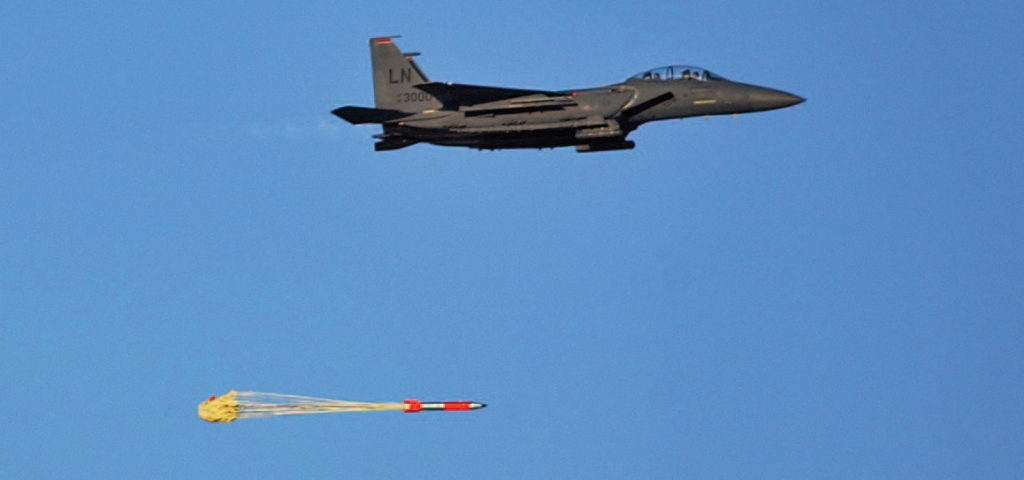
The Steadfast Noon exercise will practice employment of non-strategic nuclear weapons, like this unarmed B61-4 nuclear gravity bomb dropped by an F-15E from the 48th Fighter Wing at RAF Lakenheath. Image: Sandia National Laboratories.
[Updated version] Today, Monday October 17, 2022, the North Atlantic Treaty Organization (NATO) will begin a two-week long exercise in Europe to train aircrews in using U.S. non-strategic nuclear bombs. The exercise, known as Steadfast Noon, is centered at Kleine Brogel Air Base in Belgium, one of six airbases in Europe that store U.S. nuclear bombs. The exercise takes place midst significant modernizations at nuclear bases across Europe.
Steadfast Noon exercises are held once every year, but this year is unique because the exercise will take place during the largest conventional war in Europe since World War II with considerable tension and uncertainty resulting from Russia’s war in Ukraine. Moreover, Steadfast Noon is expected to more or less coincide with a large Russian strategic nuclear exercise. For NATO officials, other than Putin’s war in Ukraine, this is all routine. But for the public, it is but the latest development in rising tensions and unprecedented fears about nuclear war.
According to NATO, Steadfast Noon will involve 14 countries (less than half of the 30 NATO allies) and up to 60 aircraft. That involves fourth-generation F-16s and F-15Es as well as fifth-generation F-35A and F-22 fighter jets. A number of tankers and surveillance aircraft will also take part. Although the exercise is practicing NATO’s non-strategic nuclear forces, a couple of U.S. strategic B-52 bombers will also participate. Training flights will take place over Belgium and the United Kingdom as well as over the North Sea. There might also be flights over Germany and the Netherlands.
Practicing Nuclear Bomb Sharing
The Steadfast Noon exercise will practice a controversial arrangement known as nuclear sharing, under which the United States installs nuclear equipment on fighter jets of select non-nuclear NATO countries and train their pilots to carry out nuclear strike with U.S. nuclear bombs.
The arrangement is controversial because the United States as a party to the nuclear Non-Proliferation Treaty (NPT) has promised not to hand over nuclear weapons to other countries, and the non-nuclear countries in the sharing arrangement have promised not to receive nuclear weapons from the nuclear weapon states. In peacetime the nuclear weapons are under U.S. control, but the arrangement means that they would be handed over to the non-nuclear country in war time. The arrangement was in place before the NPT was signed so it is not a violation of the letter of the treaty. But it can be said to violate the spirit and has been an irritant for years.
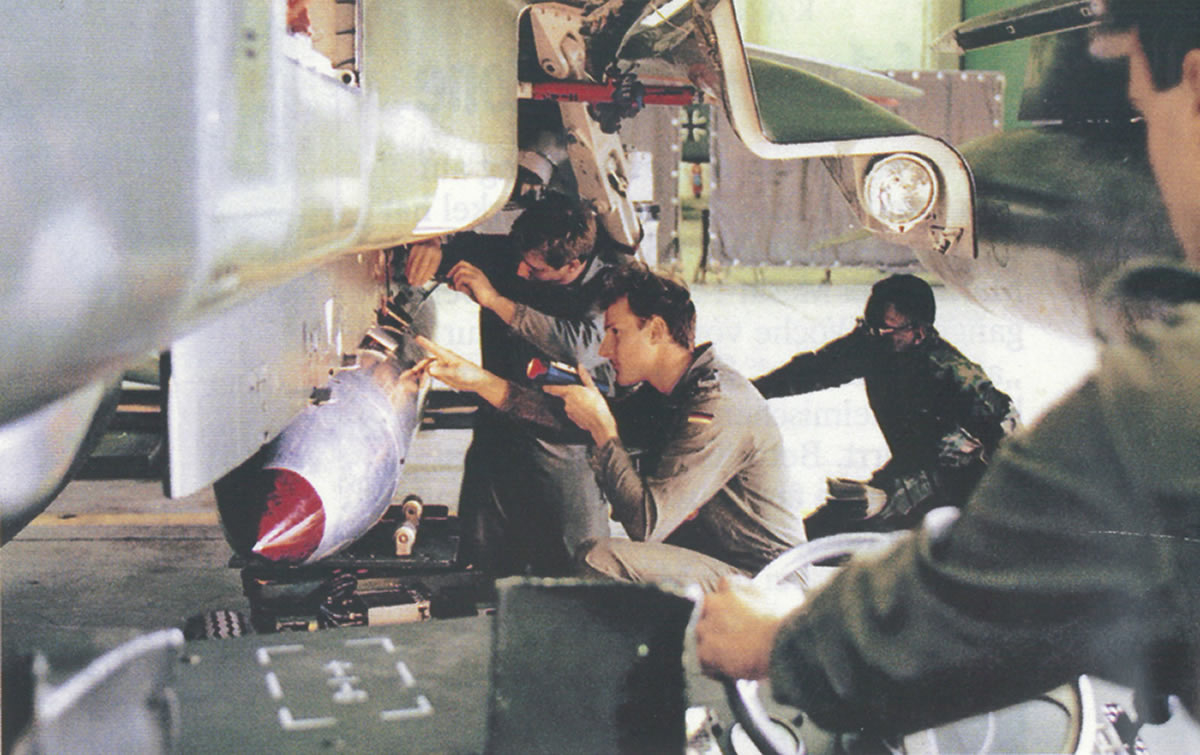
Under supervision by U.S. Air Force personnel, German Air Force personnel is practicing loading of a U.S. B61-4 nuclear bomb shape on a German Tornado fighter jet. In a war, German pilots could be given control of U.S. nuclear bombs. Image: Der Spiegel.
“If NATO was to conduct a nuclear mission in a conflict,” NATO says, “the B-61 [sic] weapons would be carried by certified Allied aircraft…However, a nuclear mission can only be undertaken after explicit political approval is given by NATO’s Nuclear Planning Group (NPG) and authorisation is received from the US President and UK Prime Minister.” It is unclear why the U.K. Prime Minister would have to authorize employment of U.S. nuclear weapons, and unless NATO territory had been attacked with nuclear weapons first, it seems unlikely that the 29 countries in the NPG would be able to agree to approve of employment of non-strategic nuclear weapons from bases in Europe.
NATO disclosed earlier this year that seven NATO countries contribute dual-capable aircraft to the nuclear sharing mission. The countries were not identified but five are widely known: Belgium, Germany, Italy, Netherlands, and the United States. The sixth country is probably Turkey (despite rumors that it was no longer part of the mission), in which case some Turkish F-16s are still equipped to deliver B61 bombs. The seventh country was a mystery, but it turns out it is Greece. Although Greece no longer stores nuclear weapons (they were withdrawn in 2001) and doesn’t have a committed fighter unit, it has a reserve units and a contingency mission. Like other allies (except France), Greece is fully involved in the NPG.]
Nuclear Base Modernizations
During the past several years, the nuclear bases and the infrastructure that support the nuclear sharing mission in Europe have been undergoing significant upgrades, including cables, command and control systems, weapons maintenance and custodial facilities, security perimeters, and runway and tarmac areas.
There are currently six active sites in Europe that store U.S. nuclear bombs: Kleine Brogel air base in Belgium, Büchel air base in Germany, Aviano and Ghedi air bases in Italy, Volkel air base in the Netherlands, and possibly Incirlik in Turkey. The estimated number of weapons at each site is based on the number of active vaults, aircraft, and other information.
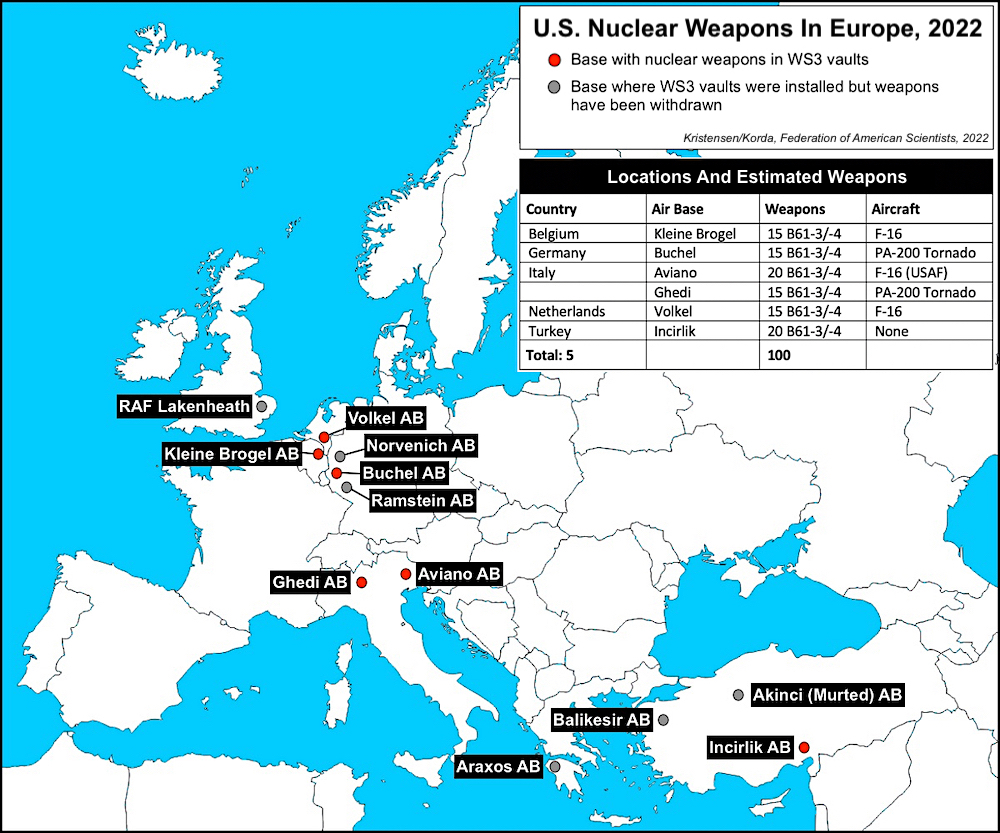
Each of these bases have one or two dozen active vaults (Weapons Storage Security System, WS3) inside as many protective aircraft shelters. Ramstein air base in Germany used to be the largest storage site in Europe but only 7 vaults remain active possibly for training and transfer. All weapons were withdrawn from Lakenheath before 2007 but the United Kingdom was recently added to the nuclear infrastructure storage modernization program, which means there are now eight active WS3 sites in Europe.

The modernizations at the various bases vary depending on capacity, location, and host country. At Kleine Brogel Air Base in Belgium, the host base for the Steadfast Noon exercise this year, the 701st Munition Support Squadron quarters have been significantly expanded with a drive-through facility for nuclear weapons maintenance trucks. Other construction includes a major facility inside the aircraft tarmac perimeter area, a new control tower, and upgrades of underground cables and the Alarm Communication & Display (AC&D) system.
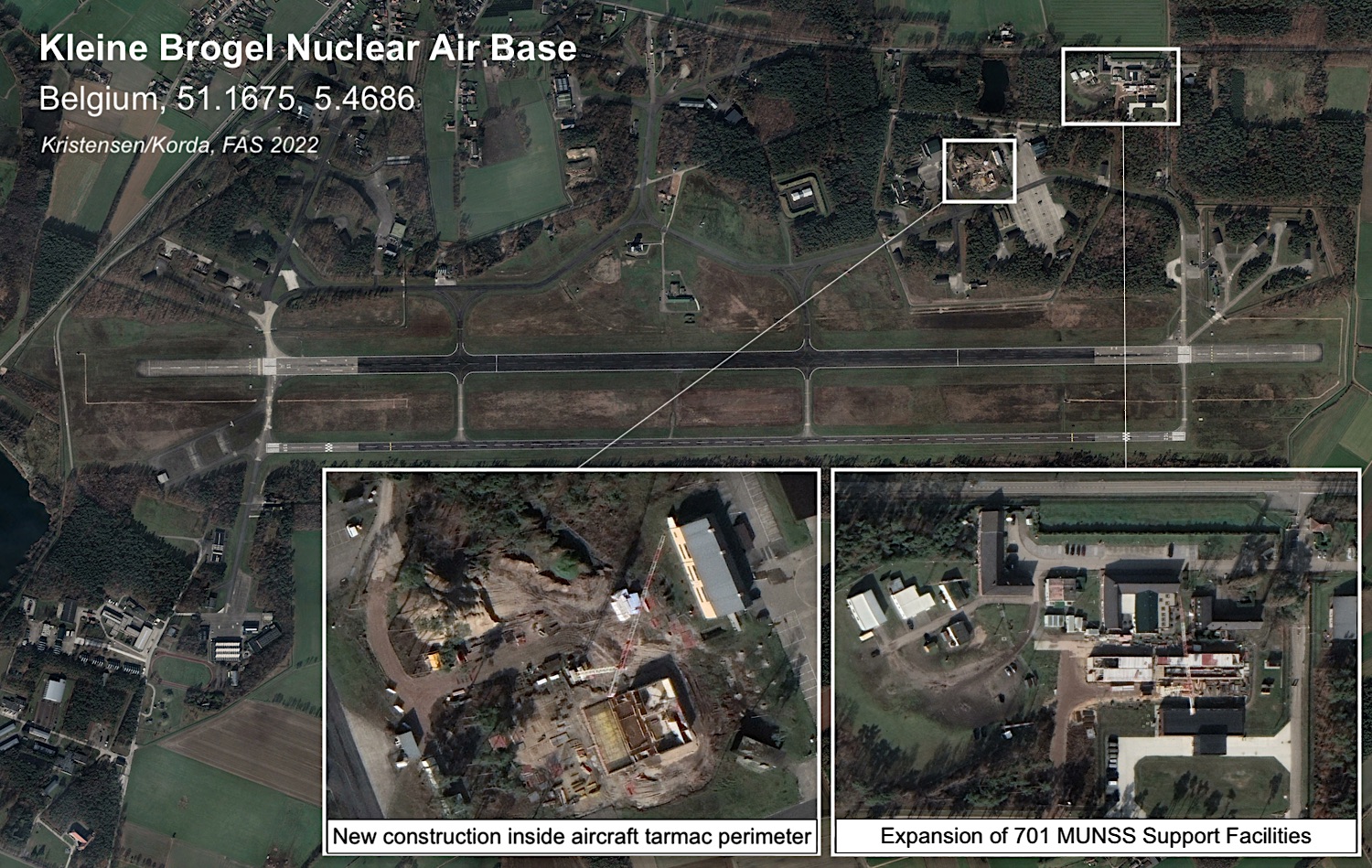
At Büchel Air Base in Germany, construction is underway on the runway. During construction, the Tornados of the 33rd Fighter Wing will be temporarily based at Norvenich Air Base. However, the 10-15 B61 nuclear bombs will remain in the vaults at Büchel. Other recent updates at the base have included underground cables and the Alarm Communication & Display (AC&D) system.
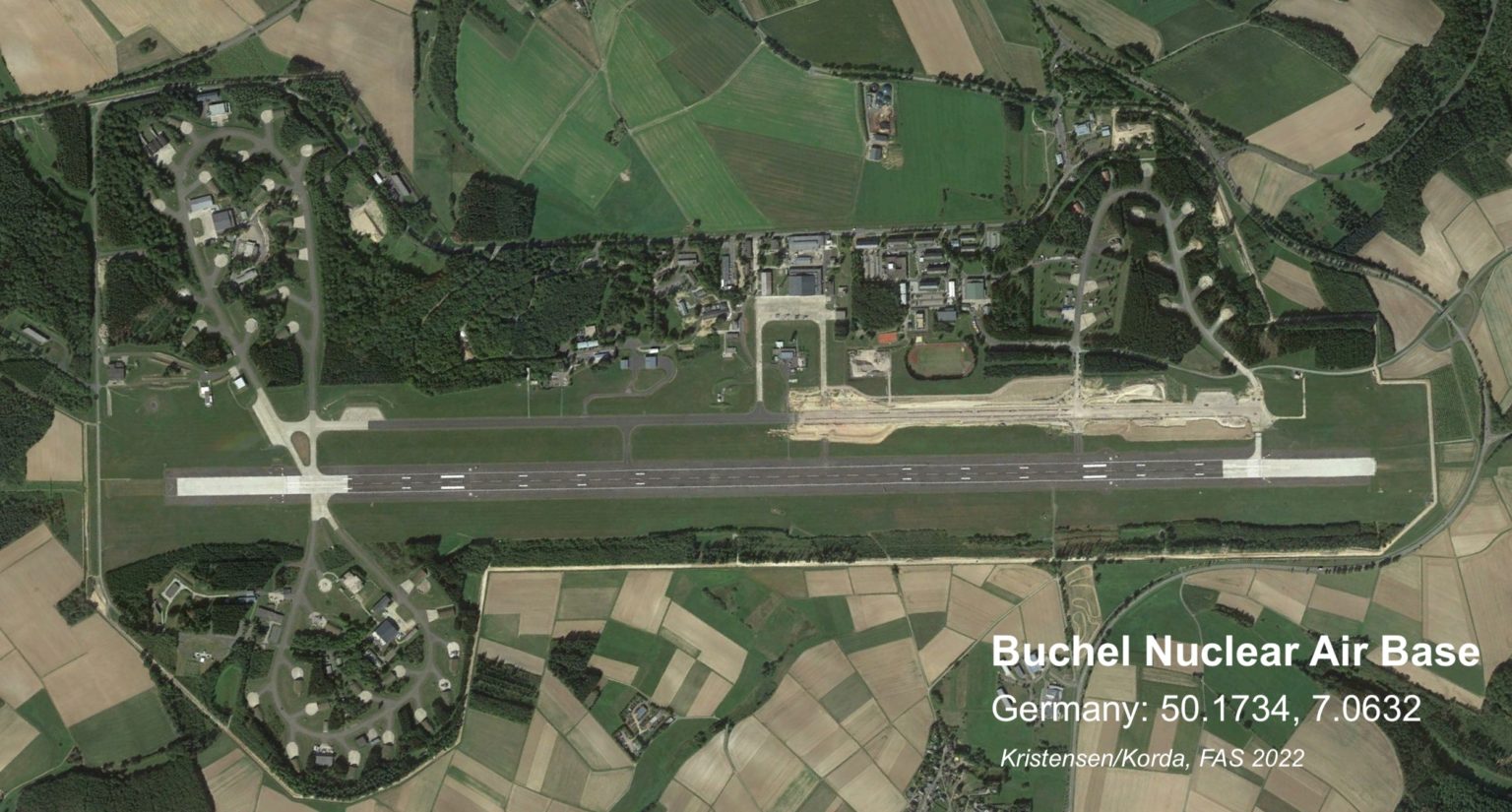
In 2020, as part of a series of visits to bases involved in the nuclear sharing mission, U.S. Air Force Maj. Gen. Derek C. France, the director of operations, strategic deterrence, and integration for U.S. Air Forces in Europe – Air Forces Africa Headquarters director of operations, strategic deterrence, and integration, visited Büchel Air Base where he received a tour and explanation of a protective aircraft shelter. A picture of the tour shows the vault open and a B61 nuclear bomb shape inside.
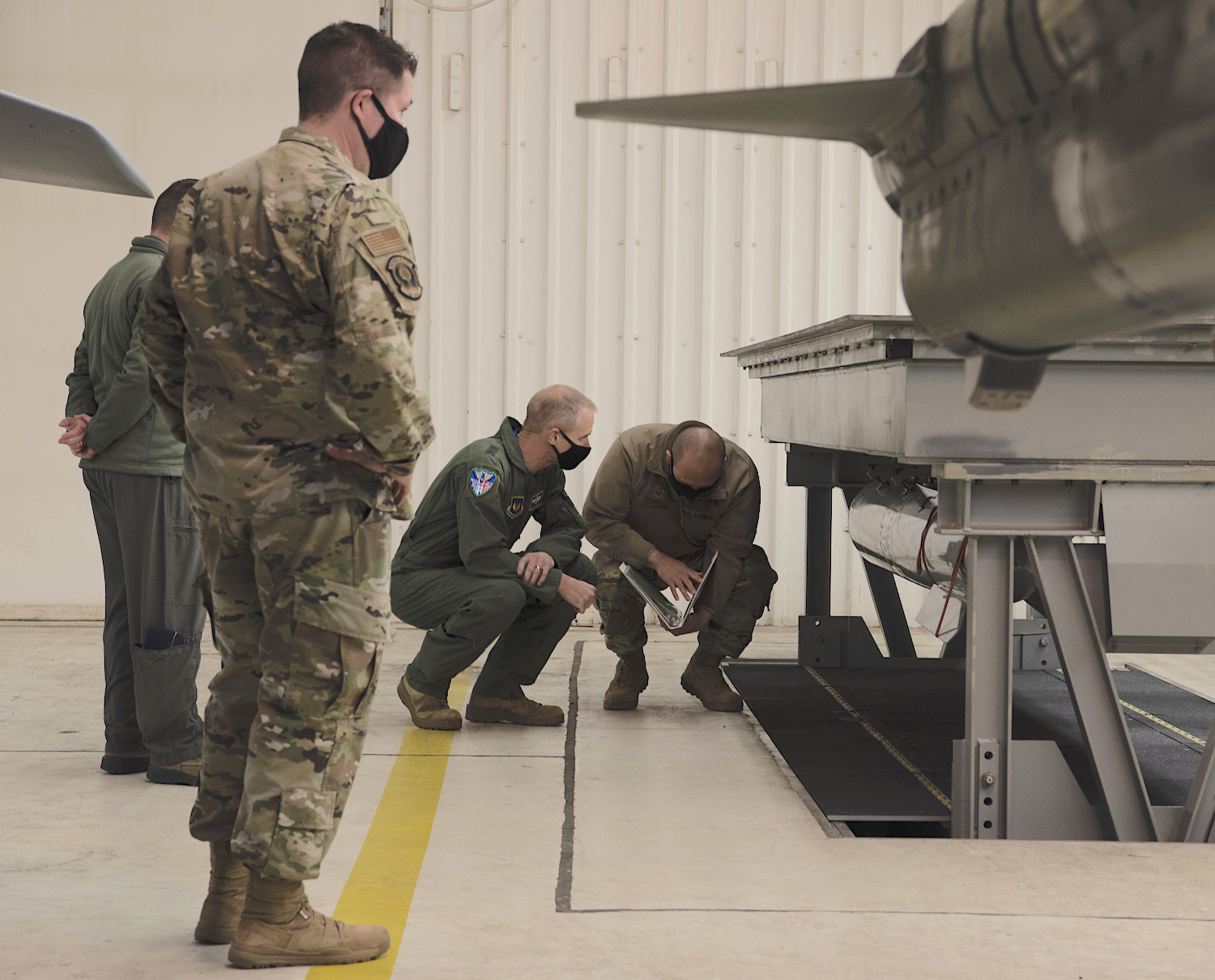
U.S. Air Force Maj. Gen. Derek C. France, U.S. Air Forces in Europe – Air Forces Africa Headquarters director of operations, strategic deterrence, and nuclear integration, received a tour of a Protective Aircraft Shelter at Büchel Air Base on October 15, 2020. The image shows a B61 nuclear bomb shape hanging in the elevated vault.
At Volkel Air Base in the Netherlands, the most visible modernization currently underway is a major new tarmac area. The construction includes security perimeters probably intended to protect the C-17 aircraft that transport weapons and components to and from the base. Other recent construction the base has included burying underground cables and upgrading the Alarm Communication & Display (AC&D) system used for the WS3 vaults.
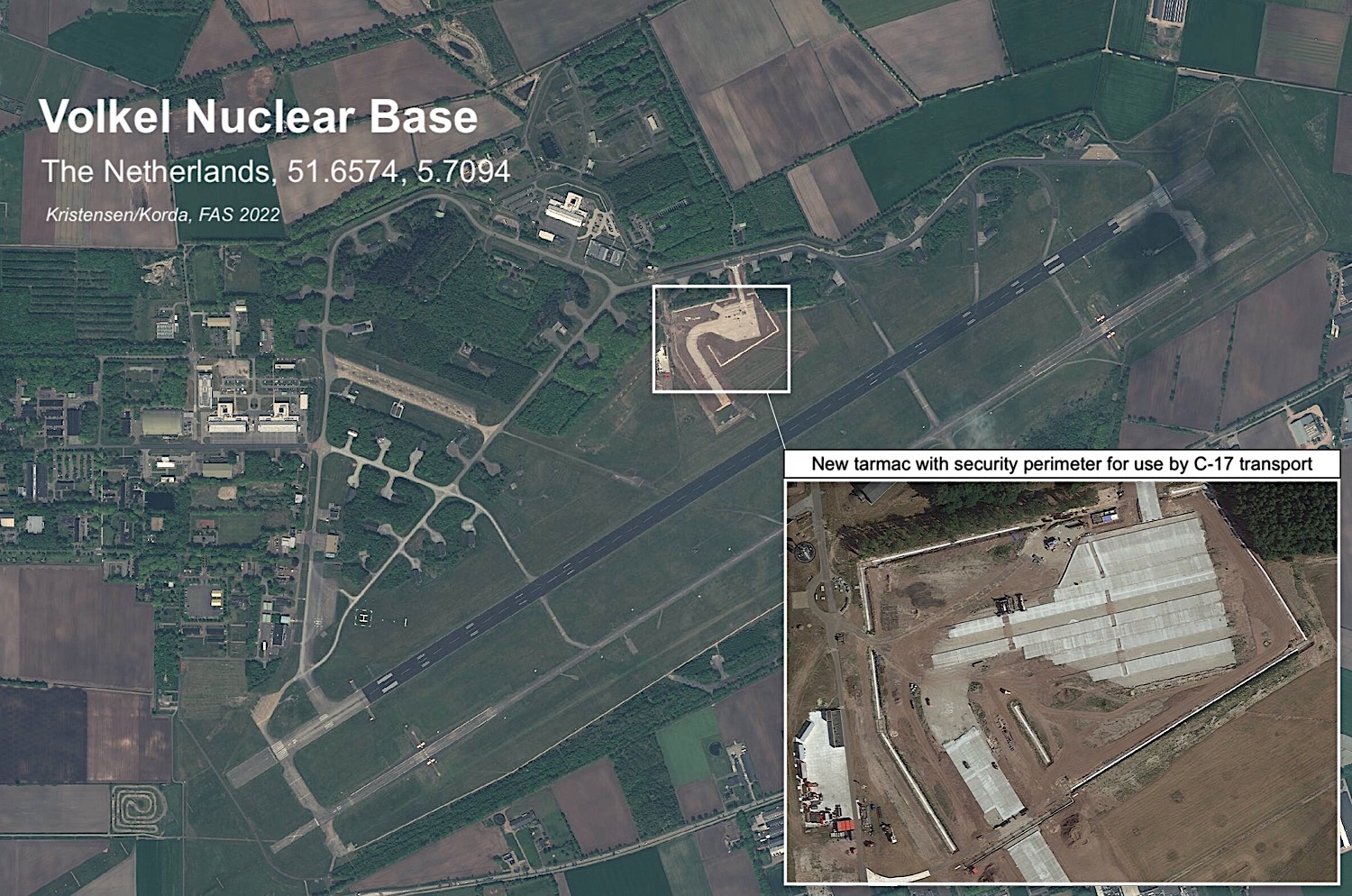
Ghedi Air Base in Italy is undergoing a dramatic upgrade that includes a new tarmac and shelter area for the new F-35A fighter jets that will replace the Tornado jets in the nuclear sharing mission. Work is also underway on what appears to be a drive-through facility for weapons maintenance trucks in the 704th MUNSS area. And a new high-security perimeter has been erected around eight vaults, possibly those of the 11 that are active. This perimeter is similar to perimeters that were constructed at Aviano and Incirlik air bases in 2014-2015. Finally, Ghedi also has received an upgrade of underground cables and the Alarm Communication & Display (AC&D) system used for the WS3 vaults.
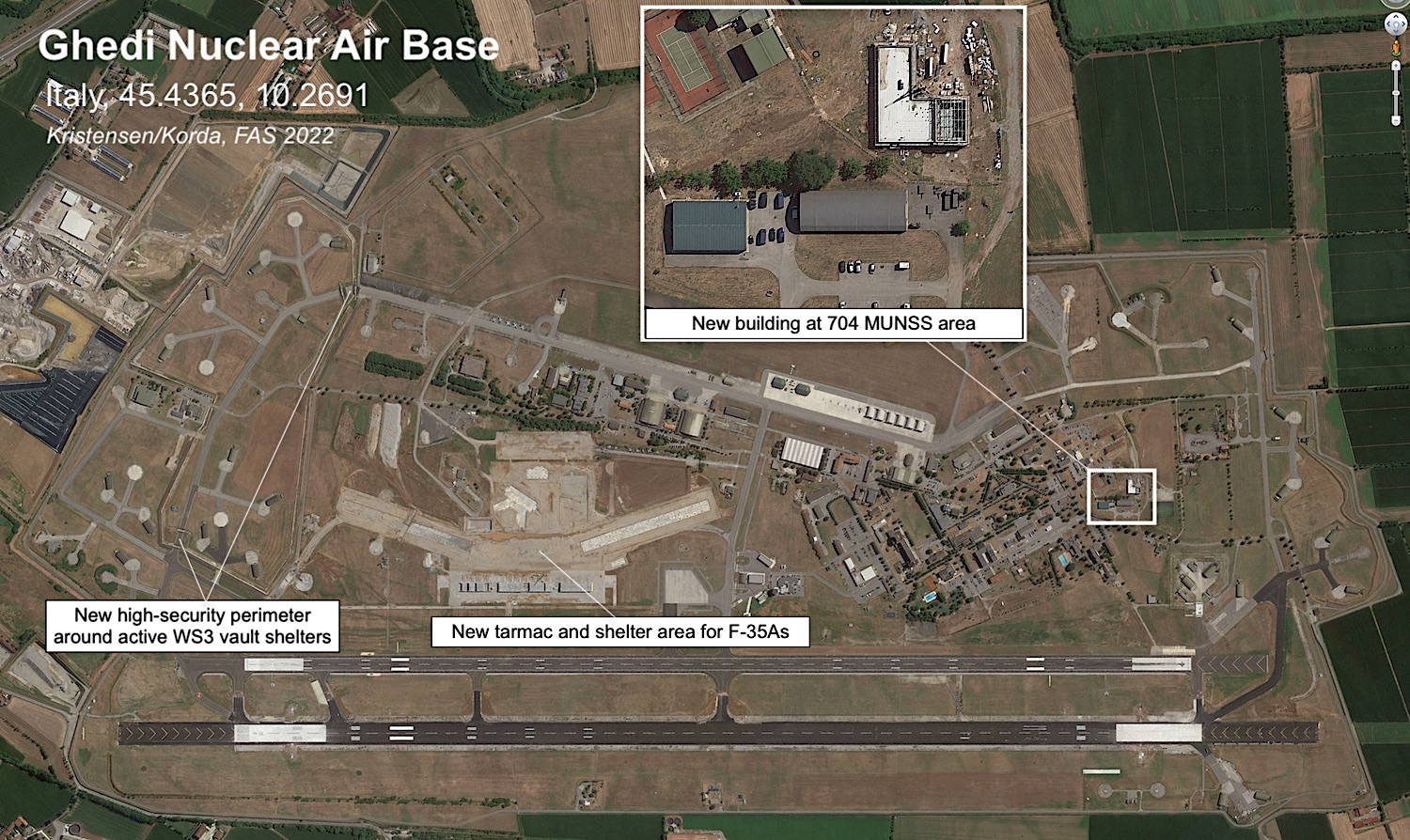
Upgrades of Aviano Air Base in Italy and Incirlik Air Base in Turkey happened around 2015 are described in this article: Upgrades At US Nuclear Bases In Europe Acknowledge Security Risk. Since then, installation of new cables between the nuclear vaults at Incirlik Air Base is visible on satellite images.

Weapons Modernization
In addition to modernization of bases and support facilities, delivery systems and weapons are also being upgraded. Five of the seven countries that contribute dual-capable aircraft to the nuclear sharing mission are upgrading to the F-35A fifth-generation fighter-bomber: Belgium, Germany, Italy, the Netherlands, and the United States. Turkey was scheduled to upgrade to F-35A but lost the contract after it purchased the Russian S-400 system.
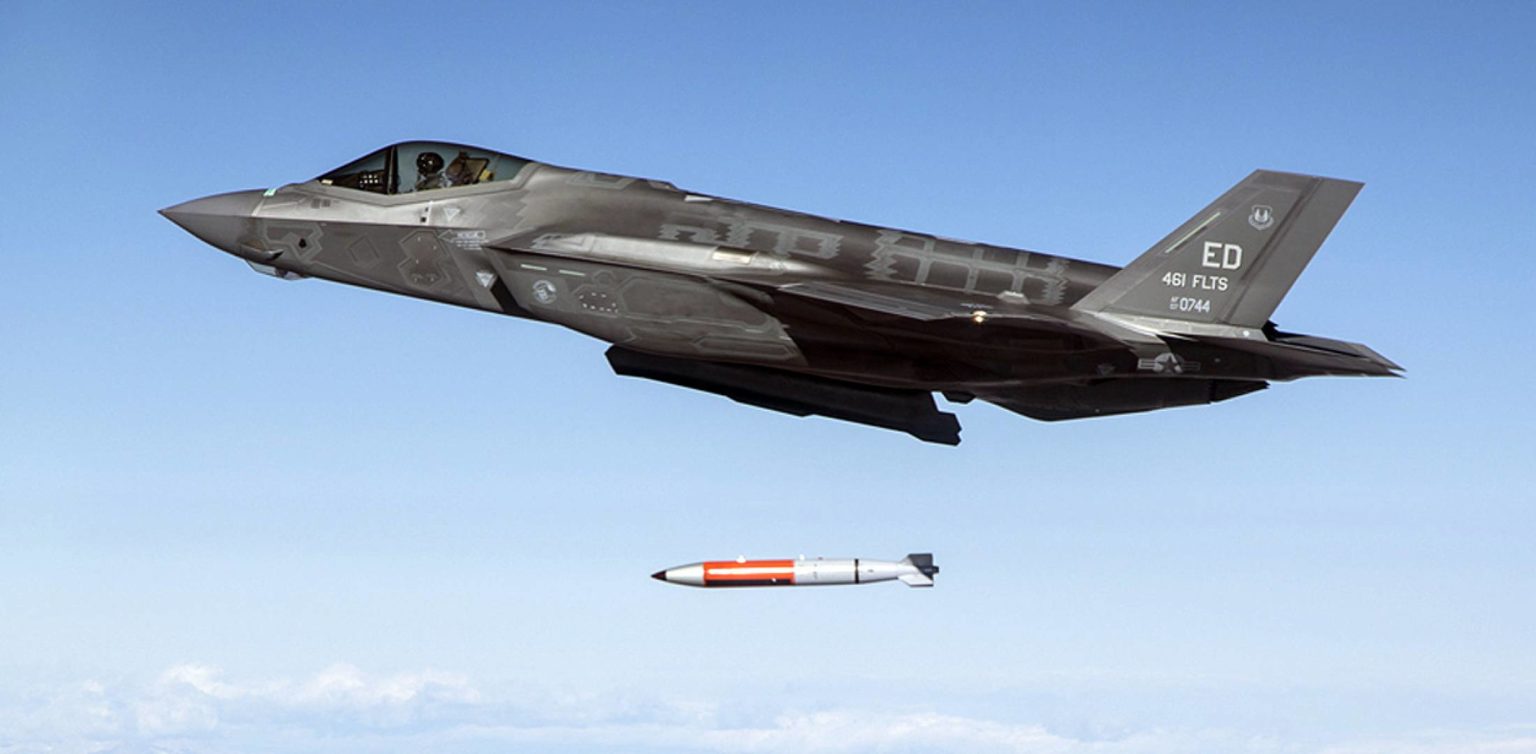
An F-35A test-drops a B61-12 guided nuclear bomb. The enhanced weapon will be compatible with both fighter jets and strategic bombers and begin replacing older B61 versions in Europe from 2023. Image: U.S. Air Force.
Finally, the existing B61 nuclear bombs will soon be replaced by the enhanced B61-12 guided nuclear bomb. Development is essentially complete and full-scale production of about 480 B61-12s is expected to begin soon. The new weapon is thought to have the same yield range as the current B61-4: 0.3, 1.5, 10 and 50 kilotons. Training of the units in Europe to receive the new weapon is scheduled to begin in early-2023 and the first weapons potentially arriving at the first base in late-2023 or 2024.
In addition to the non-strategic fighter jets F-15E, F-16, F-35A, and Tornado, the B61-12 will also be integrated on the B-2 and B-21 strategic bombers. Because of the increased accuracy provided by the tail kit, all the digital aircraft that can make use of it (all except F-16 and Tornado) will be able to hold at risk a wide range of targets. The combination of increased accuracy and lower-yield options on non-strategic and strategic stealth aircraft will significantly increase the capability of the gravity bomb mission.

Each of the WS3 vaults at European bases can hold up to four nuclear bombs. Here crews are practicing loading B61 bombs into a vault: two B61-3/4 bombs on the top rack and two B61-12 bombs on the lower rack. Image: U.S. Air Force, obtained by Joseph Trevithick (The Drive) under FOIA.
This publication was made possible by generous contributions from the John D. and Catherine T. MacArthur Foundation, the New-Land Foundation, the Ploughshares Fund, the Prospect Hill Foundation, Longview Philanthropy, the Stewart R. Mott Foundation, the Future of Life Institute, Open Philanthropy, and individual donors. The statements made and views expressed are solely the responsibility of the author.
USAF Plans To Expand Nuclear Bomber Bases
The US Air Force is working to expand the number of strategic bomber bases that can store nuclear weapons from two today to five by the 2030s.
The plan will also significantly expand the number of bomber bases that store nuclear cruise missiles from one base today to all five bombers bases by the 2030s.
The expansion is the result of a decision to replace the non-nuclear B-1B bombers at Ellsworth AFB and Dyess AFB with the nuclear B-21 over the next decade-and-a-half and to reinstate nuclear weapons storage capability at Barksdale AFB as well.
The expansion is not expected to increase the total number of nuclear weapons assigned to the bomber force, but to broaden the infrastructure to “accommodate mission growth,” Air Force Global Strike Command Commander General Timothy Ray told Congress last year.
Nuclear Bomber Base Expansion
The Air Force announced in May 2018 that the B-21 would replace the B-1B and B-2A bombers and be deployed at Ellsworth AFB, Dyess AFB, and Whiteman AFB. The commander of the strategic bomber force later explained in a video address to the B-1B bases that “the B-21 will bring significant changes to each location, to include the reintroduction of nuclear mission requirements.”
Since the B-1B was replaced in the nuclear war plan by the B-2A in 1997 and all B-1B bombers were denuclearized in 2011, the effect of the B-21 bomber program is that nuclear bomber operations will increase from the three bases today to five bases in the future (see map):
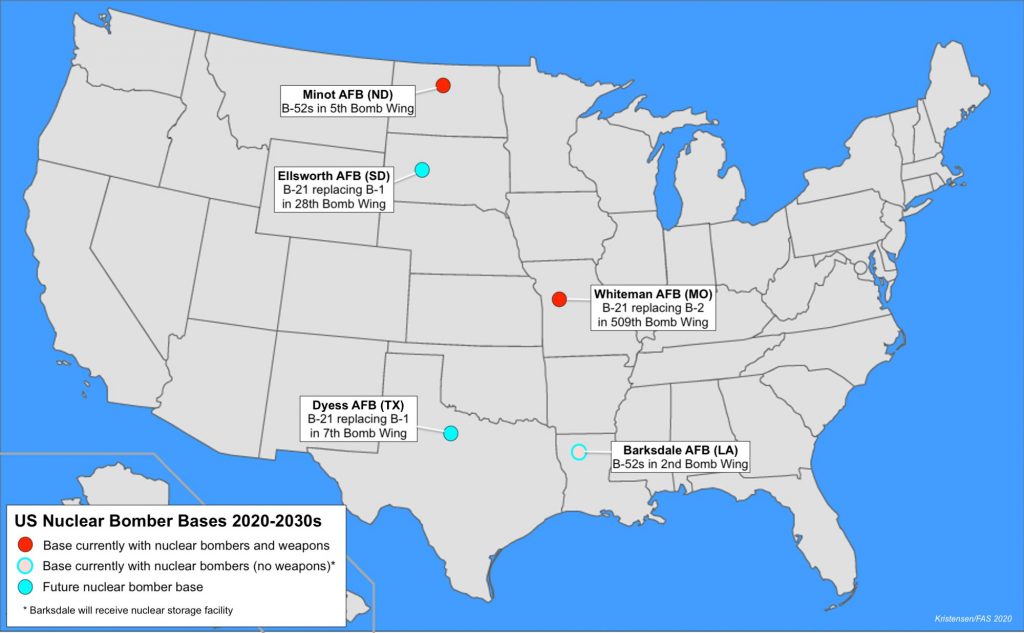
The Air Force plans to increase nuclear weapons storage capacity at bomber bases from two locations today to five in the future. Click map to view full size.
The Air Force previously planned for the B-21 to replace the B-2A no later than 2032 and the B-1Bs no later than 2036, though those dates may have shifted some since.
The effect of the integration of the B-21 is that bases with nuclear stealth bombers will increase from one today (Whiteman AFB) to three in the future.
The modernization plan also appears to significantly expand the location of nuclear cruise missiles from one base today (Minot AFB) to all five bomber bases by the late-2030s. The LRSO is scheduled to begin entering the arsenal in 2030 (see table):
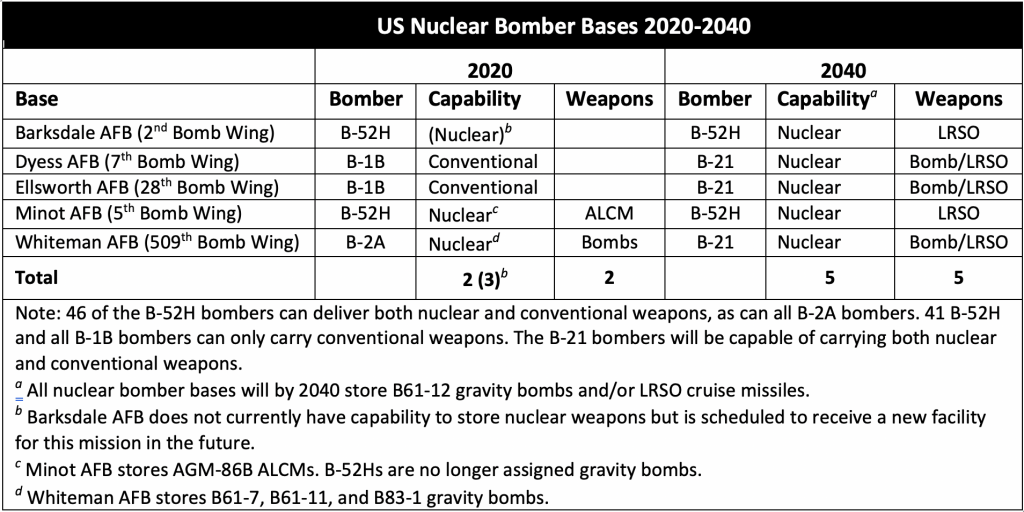
The US Air Force plans a significant expansion of nuclear bomber bases and their capabilities. Click table to view full size.
Nuclear Storage Facilities
A key element of the base upgrades to operate the B-21 involves the construction of a new nuclear weapons storage facility at each base: a Weapons Generation Facility (WGF). The new facility is different than the Weapons Storage Areas (WSAs) that that the Air Force built during the Cold War because it will integrate maintenance and storage mission sets into the same facility. The WGF will have a footprint of roughly 35 acres and include an approximately 52,000-square-foot (4,860 square meters) building as well as a 17,600 square-foot munitions maintenance building. The Air Force says the WGF will be “unique to the B-21 mission” and designed to provide a “safer and more secure location for the storage of Air Force nuclear munitions.”
An WGF is also under construction at F.E. Warren AFB for storage of ICBM warheads.
A draft Environmental Impact Statement recently posted by the Air Force shows the planned location of the nuclear weapons storage facility at Dyess and Ellsworth air force bases. At Dyess AFB, the intension is to build facility at the northern end of the base near the current munitions depot (see map below):

The Air Force plans to add nuclear weapons storage capacity to Dyess Air Force Base in Texas. Click on map to view full size.
At Ellsworth AFB, the Air Force has identified two preferred locations: one at the northern end near the munitions depot, and one at the southern end near the aircraft alert apron (see map below):

The Air Force plans to add nuclear weapons storage capacity to Ellsworth Air Force Base in South Dakota. Click on map to view full size.
Although Barksdale AFB is not scheduled to receive the B-21, preparations are underway to reinstate the capability to store nuclear weapons at the base. The capability was lost when the Air Force last decade consolidated operational nuclear ALCM storage at Minot AFB. Once completed, the new WGF will enable the base to store nuclear LRSO cruise missiles for delivery by the B-52s.
Nuclear Bomber Force Increase
The B-21 bomber program is expected to increase the overall size of the US strategic bomber force. The Air Force currently operates about 158 bombers (62 B-1B, 20 B-2A, and 76 B-52H) and has long said it plans to procure at least 100 B-21 bombers. That number now appears [https://www.airforcemag.com/article/strategy-policy-9/] to be at least 145, which will increase the overall bomber force by 62 bombers to about 220. There are currently nine bomber squadrons, a number the Air Force wants to increase to 14 (each base has more than one squadron).
During an interview with reporters in April, the head of AFGSC, General Timothy Ray, reportedly said the 220 number was a “minimum, not a ceiling” and added: “We as the Air Force now believe it’s over 220.” Whether Congress will agree to pay for that many B-21s remains to be seen.
The fielding of large numbers of nuclear-capable B-21 bombers has implications for the future development of the US nuclear arsenal. Under the New START treaty, the United States has declared it will deploy no more than 60 nuclear bombers. Although the treaty will lapse in 2026 (after a five-year maximum extension), it serves as the baseline for long-term nuclear force structure planning.
Unless the Air Force limits the number of nuclear-equipped B-21 bombers to the number of B-2As operated today, the number of nuclear bombers would begin to exceed the 60 deployed nuclear bomber pledge by 2028 (assuming an annual production of nine aircraft and two-year delay in deployment of the first nuclear unit). By 2035, the number of deployed nuclear bombers could have doubled compared with today (see graph below):
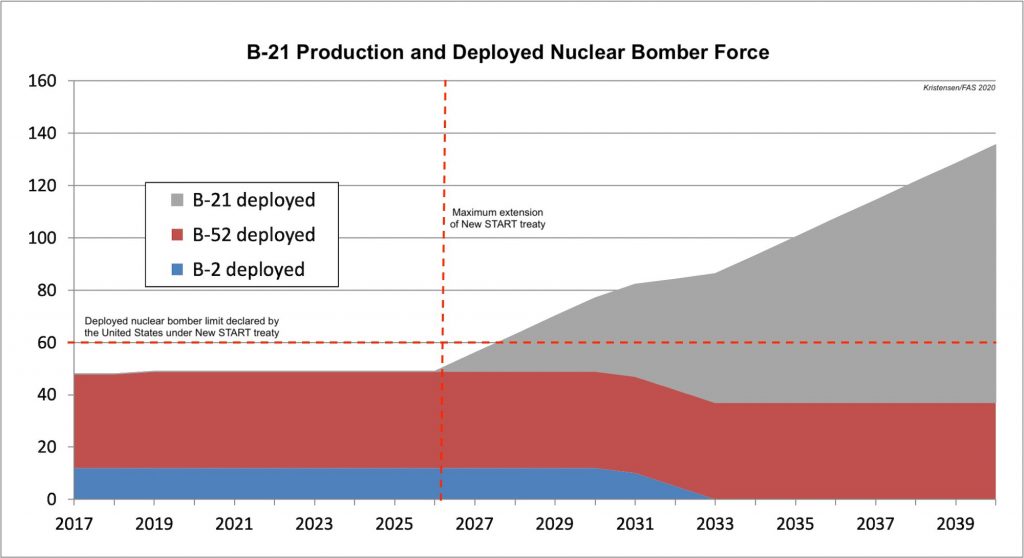
Unless nuclear B-21 bombers are not limited, the future nuclear bomber force could significantly exceed the bomber force under the current New START treaty. Click graph to view full size.
It is difficult to imagine a military justification for such an increase in the number of nuclear bombers – even without New START. One would hope that the number of nuclear B-21s will be limited to well below the total number. Although the New START treaty would have expired before this becomes a a legal issue, it would already now send the wrong message to other nuclear-armed states about US long-term intensions, deepen suspicion and “Great Power Competition,” and could complicate future arms control talks.
In the short term, the incoming Biden administration should commit the United States to not increase the number of nuclear bombers beyond those planned under the New START treaty, and it should urge Russia to make a similar declaration about the size of its nuclear bomber force.
See also: Nuclear Notebook: US nuclear force, 2020
This publication was made possible by generous contributions from the John D. and Catherine T. MacArthur Foundation, the New Land Foundation, the Ploughshares Fund, and the Prospect Hill Foundation. The statements made and views expressed are solely the responsibility of the authors.